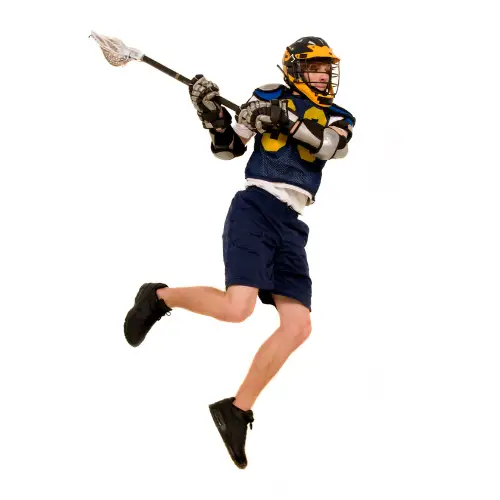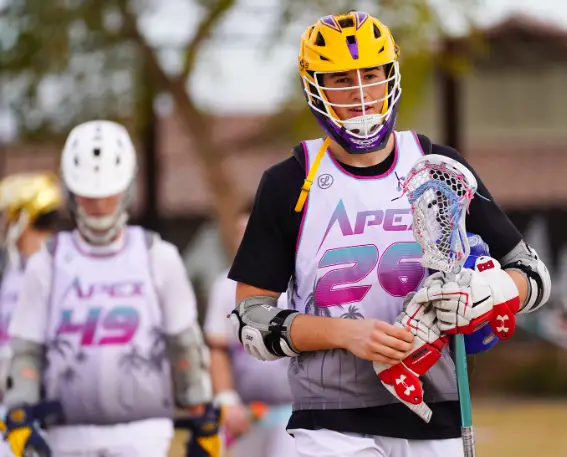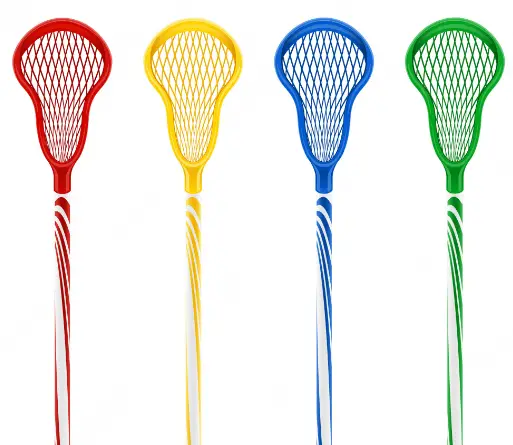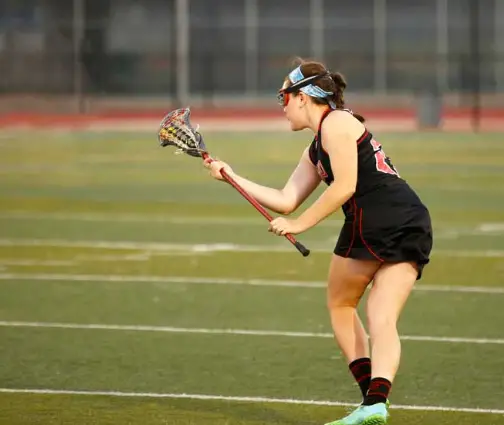As a defensive player in lacrosse, your job is to defend your goal area, prevent shots, and force turnovers. It’s important to have good footwork, stick skills, and overall defensive knowledge to be successful. Here are some of the best lacrosse drills for defensemen to improve your skills:
Footwork drills
Here are some lacrosse footwork drills that can be helpful for defensemen:
- Agility ladder drills: Set up an agility ladder and practice various footwork patterns, such as high knees, lateral shuffles, and quick feet drills. This will improve your foot speed and agility.
- Box drills: Set up four cones in the shape of a box and practice moving in and out of the box as quickly as possible. This will improve your lateral quickness and change of direction.
- Defensive shuffle drills: Have a partner stand in front of you with a ball and shuffle laterally while keeping your body squared up to them. This will help you practice staying in front of your opponent while maintaining good defensive positioning.
- Zigzag cone drill: Set up cones in a zigzag pattern and practice shuffling through them as quickly as possible. This will help you practice changing direction quickly and efficiently.
- Jump rope drills: Jump rope for a set period of time, focusing on quick feet and maintaining good form. This will help improve your foot speed and endurance.
Remember, it’s important to vary your drills and work on different aspects of your game. These drills will help you improve your footwork and become a better defender, but they should be combined with other drills and exercises that focus on other aspects of the game, such as stick skills, communication, and game strategy.
Stickhandling drills
- Figure Eight Drill: Start by holding your lacrosse stick in your dominant hand and passing the ball to your non-dominant hand. Then, move the stick in a figure-eight motion around your body, switching hands with the ball as you move. This drill will help improve your hand-eye coordination and stickhandling skills.
- One-Handed Drill: Practice cradling the ball with one hand while moving around the field. This drill will help you improve your ability to protect the ball from attackers and make quick moves.
- Tight Spaces Drill: Set up cones or markers in a tight formation and practice weaving your way through them while maintaining control of the ball. This drill will help you improve your stickhandling in tight spaces, which is crucial for defensemen.
- Wall Ball Drill: This classic lacrosse drill involves throwing the ball against a wall and catching it as it bounces back. To make this drill more challenging, try incorporating different stickhandling techniques, such as behind-the-back passes or quick dodges.
- Partner Passing Drill: Practice passing and catching the ball with a partner while incorporating stickhandling techniques. This drill will help you improve your ability to read your opponent’s movements and react quickly with your stick.
Two-man drills
Two-man drills are a great way for defensemen to work on their footwork and defensive skills in a game-like scenario. Here are a few two-man drills that can help defensemen improve their game:
- Cut-off Drill: In this drill, one player (the offensive player) starts at the top of the restraining line with a ball, and the other player (the defender) starts behind the goal line extended. The offensive player will run toward the goal while the defender runs to cut him off at the goal line extended. The defender should focus on staying between the offensive player and the goal while using good footwork to cut off the offensive player’s path to the goal.
- Recovery Drill: In this drill, two players start in front of the crease, with the offensive player standing to the side of the goal and the defender in front of the goal. The offensive player will shoot the ball, and the defender will need to recover and get back in front of the goal before the ball crosses the goal line. The defender should focus on quick footwork and good body positioning to get back in front of the goal.
- Give-and-Go Drill: In this drill, one player (the offensive player) starts with the ball at the top of the restraining line, and the other player (the defender) starts about five yards away. The offensive player will pass the ball to a teammate and then immediately cut toward the goal to receive a return pass. The defender should focus on staying with the offensive player and cutting off his path to the goal.
These two-man drills are just a few examples of the many drills that can help defensemen improve their footwork and defensive skills. By practicing these drills regularly, defensemen can develop the skills they need to be effective on the field.
Goaltender drills
- Hand-Eye Coordination Drill: This drill helps goaltenders improve their hand-eye coordination and reaction time. It involves having a partner toss a lacrosse ball at the goaltender, who must catch it with their stick or hand. The partner can vary the speed and trajectory of the tosses to challenge the goaltender.
- Crease Movement Drill: This drill focuses on footwork and positioning in the crease. Goaltenders practice moving laterally, shuffling, and stepping out to challenge shots. Coaches can use cones or markers to create different scenarios and challenge the goaltender to react quickly and move efficiently.
- Clearing Drill: Goaltenders need to be able to quickly and accurately clear the ball to their teammates after making a save. This drill involves simulating game situations, where the goaltender makes a save and then quickly looks for an open teammate to pass to. Coaches can vary the distance and angle of the pass to challenge the goaltender.
- One-on-One Drill: This drill helps goaltenders improve their one-on-one skills and decision-making. It involves setting up a one-on-one situation, where a shooter tries to score on the goaltender. The goaltender must read the shooter’s movements and make a save while staying balanced and in control.
- Box Drill: This drill focuses on quickness and agility in the crease. Goaltenders practice moving in and out of the “box” – the area directly in front of the goal – while reacting to shots from different angles. Coaches can use cones or markers to create different patterns and challenge the goaltender’s footwork.
Small-sided drill
- 2v1 Ground Ball Drill: This drill helps defensemen work on their footwork and ground ball skills. Set up a small area with three players, one offensive player and two defensive players. The offensive player tries to get to the ground ball while the two defenders try to prevent them from getting it. This drill will help defenders work on their footwork, communication, and ability to defend in tight spaces.
- 3v2 Clearing Drill: This drill helps defensemen work on their footwork and communication skills in transition situations. Set up a small area with three offensive players and two defensive players. The defensive players must work together to stop the offense from clearing the ball out of the zone. This drill will help defenders work on their footwork, communication, and ability to defend in transition.
- 1v1 Box Drill: This drill helps defensemen work on their footwork and positioning skills. Set up a small area with two players, one offensive player and one defensive player. The offensive player must try to get past the defender and score a goal. This drill will help defenders work on their footwork, positioning, and ability to defend one-on-one.
- 2v2 Ball Screen Drill: This drill helps defensemen work on their footwork and communication skills when defending ball screens. Set up a small area with four players, two offensive players and two defensive players. The offensive players set a ball screen and the defensive players must work together to defend it. This drill will help defenders work on their footwork, communication, and ability to defend ball screens.
- 4v4 Transition Drill: This drill helps defensemen work on their footwork and communication skills in transition situations. Set up a small area with eight players, four offensive players and four defensive players. The teams must work on transitioning the ball up and down the field. This drill will help defenders work on their footwork, communication, and ability to defend in transition.
Conclusion
In conclusion, these six drills are essential for any defensemen hoping to improve his stick skills, footwork, and overall defensive ability. These drills help defenders anticipate the opponent’s movements, improve their stick skills, and keep the team’s goals protected. By practicing these drills, one can excel and become one of the best defenders in the game of Lacrosse.







